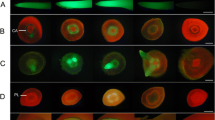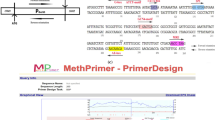Summary
A system was developed for the quantitative analysis of transcript levels in transgenic plants. It makes use of a T-DNA vector containing the intact pea rbcS-3A gene as a reference gene. At 5 kb distance from the reference gene a pseudo wild-type rbcS-3A gene was inserted with a 3′ tail derived from the related rbcS-E9 gene. Transcript levels varied between plants but the two genes were similarly affected in all cases. Analysis of chimeric genes between rbcS-3A and rbcS-E9 demonstrated that sequences upstream of — 50 are responsible for the differences in transcript abundance between the two genes. A comparison between the rbcS-3A and 3C genes showed that unlike the situation in pea, in tobacco the rbcS-3C gene is two- to threefold more highly expressed than rbcS-3A.
Similar content being viewed by others
References
Capasso O, Bleecker GC, Heintz N (1987) Sequences controlling histone H4 mRNA abundance. EMBO J 6:1825–1831
Cashmore AR (1983) Nuclear genes encoding the small subunit of ribulose-1,5-bisphosphate carboxylase. In: Kosuge T, Meredith CP, Hollaender A (eds) Genetic engineering of plants. Plenum Press, New York, pp 29–38
Choi OR, Engel JD (1986) A 3′ enhancer is required for temporal and tissue-specific transcriptional activation of the chicken adult beta-globin gene. Nature 323:731–734
Coruzzi G, Broglie R, Cashmore A, Chua N-H (1983) Tissuespecific and light-regulated expression of a pea nuclear gene encoding the small subunit of ribulose-1,5-bisphosphate carboxylase. J Biol Chem 258:1399–1402
Coruzzi G, Broglie R, Edwards C, Chua N-H (1984) Nucleotide sequences of two pea cDNA clones encoding the small subunit of ribulose 1,5-bisphosphate carboxylase and the major chlorophyll a/b binding thylakoid polypeptide. EMBO J 3:1671–1679
Dean C, van den Elzen P, Tamaki S, Black M, Dunsmuir P, Bedbrook J (1987a) Molecular characterization of the rbcS multigene family of Petunia (Mitchell). Mol Gen Genet 206:465–474
Dean C, Faveau M, Dunsmuir P, Bedbrook J (1987b) Confirmation of the relative expression levels of the Petunia (Mitchell) rbcS genes. Nucleic Acids Res 15:4655–4668
Fluhr R, Kuhlemeier C, Nagy F, Chua N-H (1986a) Organ-specific and light-induced expression of plant genes. Science 232:1106–1112
Fluhr R, Moses P, Morelli G, Coruzzi G, Chua N-H (1986b) Expression dynamics of the pea rbcS multigene family and organ distribution of the transcripts. EMBO J 5:2063–2071
Fraley RT, Rogers SG, Horsch RB, Eichholtz DA, Flick JS, Fink CL, Hoffmann N, Sanders P (1985) The SEV system: a new disarmed Ti plasmid vector system for plant transformation. Bio/Technology 3:629–635
Green PJ, Kay SA, Chua N-H (1987) Sequence-specific interactions of a pea nuclear factor with light-responsive elements upstream of the rbcS-3A gene. EMBO J 6:2543–2549
Heintz N, Roeder RG (1984) Transcription of human histone genes in extracts from synchronized HeLa cells. Proc Natl Acad Sci USA 81:1713–1717
Jones JDG, Dunsmuir P, Bedbrook J (1985) High level expression of introduced chimaeric genes in regenerated transformed plants. EMBO J 4:2411–2418
Kay R, Chan A, Daly M, McPherson F (1987) Duplication of CaMV 35S promoter sequences creates a strong enhancer for plant genes. Science 236:1299–1302
Kuhlemeier C, Fluhr R, Green PJ, Chua N-H (1987a) Sequences in the pea rbcS gene have homology to constitutive mammalian enhancers but function as negative regulatory elements. Genes Dev 1:247–255
Kuhlemeier C, Green PJ, Chua N-H (1987b) Regulation of gene expression in higher plants. Annu Rev Plant Physiol 38:221–257
Levis R, Hazelrigg T, Rubin G (1985) Effect of genomic position on the expression of transduced copies of the white gene of Drosophila. Science 229:558–561
Lüscher B, Stauber C, Schindler R, Schümperli D (1985) Faithful cell-cycle regulation of a recombinant mouse histone H4 gene is controlled by sequences in the 3′-terminal part of the gene. Proc Natl Acad Sci USA 82:4389–4393
Morelli G, Nagy F, Fraley RT, Rogers SG, Chua N-H (1985) A short conserved sequence is involved in the light-inducibility of a gene encoding ribulose 1,5-bisphosphate carboxylase small subunit. Nature 315:200–204
Morris T, Marashi F, Weber L, Hickey E, Greenspan D, Bonner J, Stein J, Stein G (1986) Involvement of the 5′-leader sequence in coupling the stability of a human H3 histone mRNA with DNA replication. Proc Natl Acad Sci USA 83:981–985
Nagy F, Morelli G, Fraley RT, Rogers SG, Chua N-H (1985) Photoregulated expression of a pea rbcS gene in leaves of transgenic plants. EMBO J 4:3063–3068
Picard D, Schaffner W (1984) A lymphocyte-specific enhancer in the mouse immunoglobulin kappa gene. Nature 307:80–82
Queen C, Baltimore D (1983) Immunoglobulin gene transcription is activated by downstream sequence elements. Cell 33:741–748
Rossi P, DeCrombrugghe B (1987) Identification of a cell-specific transcriptional enhancer in the first intron of the mouse alpha2 (type I) collagen gene. Proc Natl Acad Sci USA 84:5590–5594
Timko MP, Kausch AP, Hand JM, Cashmore AR, Herrera-Estrella L, Van den Broeck G, Van Montagu M (1985a) Structure and expression of nuclear genes encoding polypeptides of the photosynthetic apparatus. In: Steinback KE, Bonitz S, Arntzen CJ, Bogorad L (eds) Molecular biology of the photosynthetic apparatus. Cold Spring Harbor Laboratory Press, New York, pp 378–380
Timko MP, Kausch AP, Castresana C, Fassler L, Herrera-Estrella L, Van den Broeck G, Van Montagu M, Schell J, Cashmore AR (1985b) Light regulation of plant gene expression by an upstream enhancer-like element. Nature 318:579–582
Treisman R, Maniatis T (1986) Simian virus 40 enhancer increases number of RNA polymerase II molecules on linked DNA. Nature 315:72–75
Tumer NE, Clark WG, Tabor GJ, Hironaka CM, Fraley RT, Shah DM (1986) The genes encoding the small subunit of ribulose-1,5-bisphosphate carboxylase are expressed differentially in petunia leaves. Nucleic Acids Res 14:3325–3342
Weber F, Schaffner W (1986) Simian virus 40 enhancer increases RNA polymerase density within the linked gene. Nature 315:75–77
Author information
Authors and Affiliations
Additional information
Communicated by R.B. Goldberg
Rights and permissions
About this article
Cite this article
Kuhlemeier, C., Fluhr, R. & Chua, NH. Upstream sequences determine the difference in transcript abundance of pea rbcS genes. Mol Gen Genet 212, 405–411 (1988). https://doi.org/10.1007/BF00330843
Received:
Issue Date:
DOI: https://doi.org/10.1007/BF00330843




